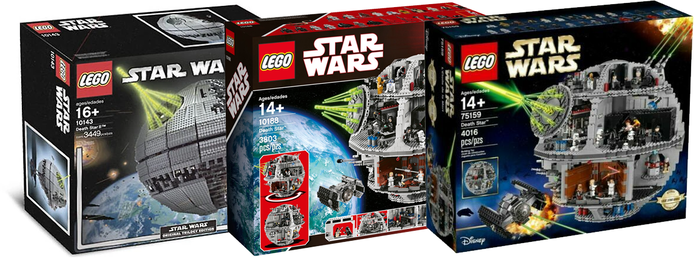
In the pantheon of LEGO collaborations, few resonate as deeply with fans as the marriage between LEGO and the Star Wars universe. Within this interstellar partnership, the daunting task of miniaturizing the infamous Death Star has yielded some of the most memorable sets in the LEGO Star Wars lineup. The Death Star, a gargantuan space station with the chilling capability to obliterate entire planets, has been a central piece in the Star Wars narrative, featuring prominently in "A New Hope," "Return of the Jedi," and making a nostalgic return in "The Rise of Skywalker." This article aims to navigate through the stellar journey of LEGO's Death Star sets, comparing the three major iterations that have landed in the hands of collectors over the years.
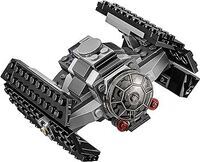 Embarking on this intergalactic retrospective, it's crucial to clarify that our focus will be on the sets that endeavor to capture the entirety of the Death Star, steering clear of sets that only depict fragments of this colossal construct. With this scope in mind, let's delve into the evolution of LEGO's Death Star models, starting with the inaugural version that set the standard for what was to come.
Embarking on this intergalactic retrospective, it's crucial to clarify that our focus will be on the sets that endeavor to capture the entirety of the Death Star, steering clear of sets that only depict fragments of this colossal construct. With this scope in mind, let's delve into the evolution of LEGO's Death Star models, starting with the inaugural version that set the standard for what was to come.
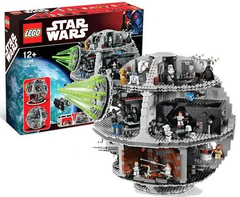 The first LEGO rendition of the Death Star to grace the shelves was the Death Star II (set 10143-1), launched in 2005 as part of the Ultimate Collector Series (UCS). Priced at $269.99/£249.99 upon release, this set has since ascended to legendary status among collectors, with its value skyrocketing on secondary markets. This model distinguished itself by prioritizing aesthetics, meticulously recreating the Death Star's iconic exterior with an impressive attention to detail. From the intricate paneling to the menacing super-laser dish, the set captured the essence of the Death Star as seen in "Return of the Jedi," including its under-construction appearance. The clever use of plates and detailing to replicate the incomplete sections of the Death Star was a testament to LEGO's commitment to authenticity, making it a standout display piece.
The first LEGO rendition of the Death Star to grace the shelves was the Death Star II (set 10143-1), launched in 2005 as part of the Ultimate Collector Series (UCS). Priced at $269.99/£249.99 upon release, this set has since ascended to legendary status among collectors, with its value skyrocketing on secondary markets. This model distinguished itself by prioritizing aesthetics, meticulously recreating the Death Star's iconic exterior with an impressive attention to detail. From the intricate paneling to the menacing super-laser dish, the set captured the essence of the Death Star as seen in "Return of the Jedi," including its under-construction appearance. The clever use of plates and detailing to replicate the incomplete sections of the Death Star was a testament to LEGO's commitment to authenticity, making it a standout display piece.
However, LEGO wasn't content to rest on its laurels and, in 2008, introduced a new Death Star set (10188-1) that took a different approach. This version was a playground for imagination, designed with playability at its heart. It was a minifigure-scale model that brought to life iconic scenes from the Original Trilogy, from the harrowing rescue of Princess Leia to the tense briefing room confrontation with Vader. This set was a masterstroke in fan service, blending iconic moments with interactive features to enhance playability within its spherical confines. The inclusion of a Tie Advanced and a diverse cast of characters, from multiple iterations of Luke and Han to the sinister Darth Vader and Emperor Palpatine, enriched the set's narrative potential, making it a treasure trove for fans of the saga.
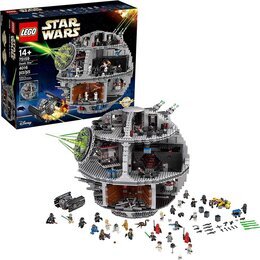 The narrative of LEGO's Death Star sets took a familiar turn with the release of the Ultimate Collector Series: Death Star (75159-1), which sought to refine the 2008 model with updated minifigures and additional details. Despite its enhancements and the introduction of new characters, the set's significant price increase was a point of contention among fans. While the set offered a refreshed experience, it struggled to justify its heightened cost, especially when compared to the groundbreaking ingenuity of its predecessor.
The narrative of LEGO's Death Star sets took a familiar turn with the release of the Ultimate Collector Series: Death Star (75159-1), which sought to refine the 2008 model with updated minifigures and additional details. Despite its enhancements and the introduction of new characters, the set's significant price increase was a point of contention among fans. While the set offered a refreshed experience, it struggled to justify its heightened cost, especially when compared to the groundbreaking ingenuity of its predecessor.
In the grand scheme of LEGO Star Wars lore, each Death Star set has its own unique allure, whether it's the aesthetic precision of the Death Star II, the immersive playability of the 2008 Death Star, or the refined updates of the latest iteration. Each model invites fans to explore the Death Star's legacy from a different perspective, whether they seek to admire its daunting silhouette on their shelf or relive the saga's most thrilling moments through interactive play. As we reflect on these celestial creations, it's clear that LEGO's foray into the heart of the Empire remains a cornerstone of its intergalactic offerings, capturing the imagination of Star Wars enthusiasts across the galaxy.
Let's deep dive into each LEGO Death Star set, the big ones that is...
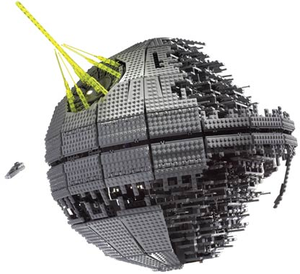 2005, 10143 Death Star II
2005, 10143 Death Star II
The LEGO set 10143, Death Star II, is part of LEGO's Ultimate Collector's Series, a range designed for the most dedicated and experienced LEGO enthusiasts. This set stands out for its complexity and impressive scale, consisting of over 3,400 pieces. Its design aims to replicate the iconic, yet incomplete appearance of the Death Star II as seen in "Star Wars: Episode VI – Return of the Jedi." The set's complexity is not just in the number of pieces but in the intricate detailing that accurately captures the partially constructed state of the Death Star, showcasing the superlaser's focus lens and various panels and towers.
Released in 2005, this set is considered a collector's item and is revered for its attention to detail and the challenge it presents to builders. It stands at a significant height of over 25 inches (63.5cm) when completed, making it one of the larger and more imposing models in the LEGO Star Wars collection. The Death Star II does not include minifigures, unlike many other sets; its focus is on the architectural accuracy and scale, appealing to adult fans and collectors who appreciate the model's complexity and display-worthy aesthetics. This set is a testament to LEGO's commitment to capturing the essence of the Star Wars universe in a form that offers both a challenging build and a remarkable display piece.
What is the current value of the LEGO Death Star II?
2008, 10188 Death Star
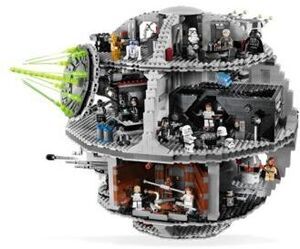 The LEGO set 10188 Death Star is a meticulously crafted representation of the Galactic Empire's formidable space station as depicted in the original Star Wars trilogy. Released in 2008, this set is renowned for its complexity and the depth of detail that mirrors the iconic scenes and architecture from the films.
The LEGO set 10188 Death Star is a meticulously crafted representation of the Galactic Empire's formidable space station as depicted in the original Star Wars trilogy. Released in 2008, this set is renowned for its complexity and the depth of detail that mirrors the iconic scenes and architecture from the films.
With over 3,800 pieces, the set is a comprehensive model that includes numerous rooms and areas recognizable from key moments in the movies. These include the Emperor Palpatine's throne room, a pivotal location from "Return of the Jedi," where the final confrontation between Luke Skywalker, Darth Vader, and the Emperor takes place. The set also features a hangar bay equipped with a TIE Advanced starfighter, similar to the one Darth Vader pilots during the Battle of Yavin in "A New Hope."
 The detention block and trash compactor scenes from "A New Hope" are intricately recreated, complete with a model of the Dianoga trash compactor monster. The Death Star's superlaser control room is another highlight, showcasing the weapon's immense power used to destroy planets.
The detention block and trash compactor scenes from "A New Hope" are intricately recreated, complete with a model of the Dianoga trash compactor monster. The Death Star's superlaser control room is another highlight, showcasing the weapon's immense power used to destroy planets.
The set includes an impressive array of 24 minifigures, offering a wide range of characters from the series. Notable figures include Luke Skywalker in his Jedi Knight attire, Princess Leia in her Hoth outfit, Han Solo in both his regular and Stormtrooper disguises, and Darth Vader. The inclusion of lesser-seen characters such as Grand Moff Tarkin, an Imperial Officer, and Death Star Troopers adds to the set's authenticity and collectibility.
What is the current value of the LEGO Death Star (10188)?
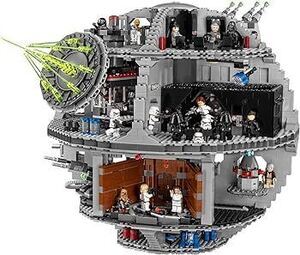 2016, 75159 The Death Star
2016, 75159 The Death Star
The LEGO Death Star set (75159) is part of LEGO's Star Wars Ultimate Collector's Series, a reimagined version of the earlier 10188 Death Star set, designed to bring even more detail and authenticity to the iconic space station from the Star Wars saga. Released in 2016, this set is a testament to LEGO's commitment to continually enhancing the building experience and offering new levels of immersion and complexity to fans.
With over 4,000 pieces, 75159 The Death Star is a formidable build that captures the essence of the massive space station, focusing on the interior scenes and key moments from the original trilogy. The set is designed to be both a collector's item and a playset, featuring an array of meticulously detailed rooms and areas that are iconic to the movies, such as the Emperor's throne room, a detention block, a trash compactor, and a hangar bay complete with a TIE Advanced fighter.
 One of the standout features of 75159 is its impressive lineup of minifigures, totaling 23, including characters like Luke Skywalker, Princess Leia, Han Solo, Darth Vader, Emperor Palpatine, and many others, some of which are unique to this set or have been updated from previous versions. This diverse cast allows for the recreation of numerous classic scenes, from the dramatic duel between Luke and Darth Vader to the tense moments in the detention block and trash compactor.
One of the standout features of 75159 is its impressive lineup of minifigures, totaling 23, including characters like Luke Skywalker, Princess Leia, Han Solo, Darth Vader, Emperor Palpatine, and many others, some of which are unique to this set or have been updated from previous versions. This diverse cast allows for the recreation of numerous classic scenes, from the dramatic duel between Luke and Darth Vader to the tense moments in the detention block and trash compactor.
The set is engineered for interaction, with moving parts like the superlaser, turbo laser cannons, and elevators, adding an extra layer of playability. The design also facilitates easy access to the different sections, making it an engaging play experience as well as a display piece. Measuring over 16 inches (41cm) high and 16 inches (42cm) wide, 75159 The Death Star is a significant presence in any collection, embodying the scale and complexity of the Galactic Empire's most fearsome weapon.
What is the current value of the LEGO Death Star (75159)?
A little bit of Death Star history
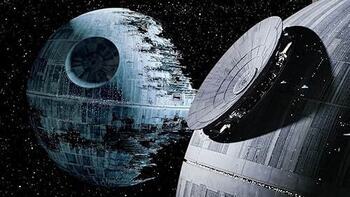 The Death Star, an iconic superweapon in the Star Wars universe, has a rich history both within the fictional galaxy and in the real world as a concept in the Star Wars franchise. Its origins trace back to early drafts of the original 1977 Star Wars film, written and directed by George Lucas. Initially conceived as a menacing symbol of the Galactic Empire's power, the Death Star was designed as a moon-sized space station capable of destroying entire planets with its superlaser. The concept was inspired by science fiction stories and the real-world fear of nuclear weapons, serving as a stark representation of ultimate power and technological terror.
The Death Star, an iconic superweapon in the Star Wars universe, has a rich history both within the fictional galaxy and in the real world as a concept in the Star Wars franchise. Its origins trace back to early drafts of the original 1977 Star Wars film, written and directed by George Lucas. Initially conceived as a menacing symbol of the Galactic Empire's power, the Death Star was designed as a moon-sized space station capable of destroying entire planets with its superlaser. The concept was inspired by science fiction stories and the real-world fear of nuclear weapons, serving as a stark representation of ultimate power and technological terror.
In the Star Wars narrative, the first Death Star's construction was commissioned by Emperor Palpatine to solidify the Empire's grip on the galaxy and to intimidate rebel factions into submission. It was depicted as a project of immense scale and secrecy, involving the enslavement of countless individuals and the exploitation of resources from numerous planets. The Death Star's first on-screen appearance in "Star Wars: Episode IV - A New Hope" showcased its formidable power by destroying the planet Alderaan. This act of unparalleled aggression set the stage for the Rebel Alliance's desperate efforts to exploit a critical vulnerability in the Death Star's design, leading to its dramatic destruction at the hands of Luke Skywalker, and marking a pivotal moment in the Galactic Civil War within the Star Wars saga.